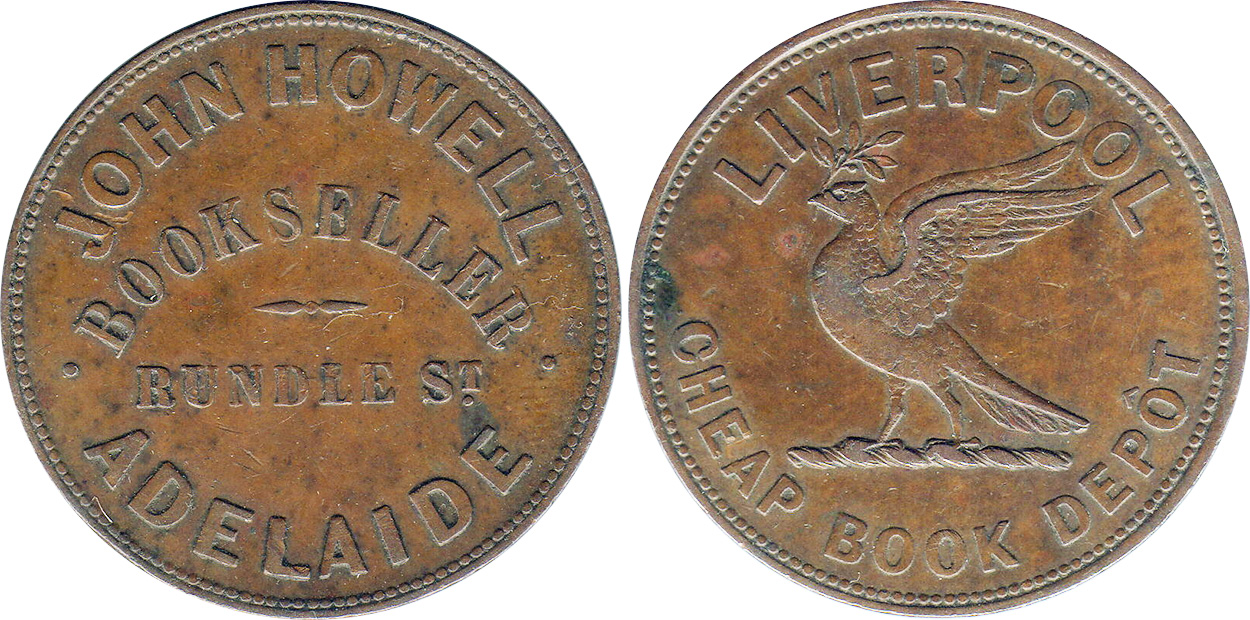John Howell, Bookseller & Printer, Adelaide, South Australia
By Museums Victoria | Tuesday, 5 November 2019
The earliest mention of a John Howell found in this survey was 1851, when a Clerk by that name was listed as residing in North Adelaide. The earliest mention of a bookseller by this name was in 1855 when he had a premises in Hindley Street and in Strangways Terrace, North Adelaide. This survey has not established whether or not these two listings refer to the same man.
Howell compiled his own 'Directory for the City and Port of Adelaide.' In his advertisement at the start of the directory for 1858, he gave his address as 11 Hindley Street, Adelaide. His advertisement inside the directory carried as its main line 'Account book manufacturer'. The Mortlock Library (Adelaide) holds several editions for years between 1858 and 1877. Only the 1858 edition was available for consultation during this survey.
Howell seems to have built a substantial business quite rapidly. During 1858 he took out extensive advertisements in the Books and Stationery advertisements section of the Adelaide Advertiser. His advertised goods included: 'Man Know Thyself, or phrenology made practical, by F. Bridges, of Liverpool, cloth, with many cuts. Price, 5s.'; 'Wesley's Hymns from 1s. 6d. Each'; and 'Ransome's and Sim's superior copying presses on Sale Wholesale and Retail, by John Howell, 11 Hindley Street.'
As well as producing his own almanac, Howell advertised in the Lewis' Almanac for 1859, with a picture of his 'Liverpool Cheap book and stationery depot' at 'No. 11 Hindley Street.'
In 1864 he advertised in the Adelaide Almanac, taking out a full page with a detailed engraving of his shop. By this time he had moved to 4 Rundle Street. In addition to his books, music and stationery, his advertisement prominently announced that his business was a 'Depository of the Society for the promotion of Christian Knowledge.' He kept this address until the end of the survey period, 1871.
From 1865 he was one of the three agents for the Adelaide Almanac, and in 1871 he was the sole agent for that publication.
The Mortlock Library lists his publications under the heading 'John Howell and Son' so, presumably, at some stage in his career Howell brought his son into the business. In addition to his Almanacs, the Mortlock also holds 'Howell's veterinarian's pharmacopoeia' published in 1863.
John Howell issued two main varieties of tokens, one giving his address as Hindley Street, the other saying Rundle street. The Museum Victoria Catalogue gives their respective years of issue as c.1857 and c.1858. This second date must be too early, as he advertised his Hindley street address in an 1859 almanac.
Reverse 2 has the date below the house, the flag-mast goes between the two N's of PENNY. The John Howell token issue records an address change from Hindley (obverse A) to Rundle streets. At Rundle two slightly different obverse dies were employed - these are most easily differentiated by the form of stop under the T of ST; if a line it is obverse B if a bead it is obverse C. The reverse seems to have employed only one die but it may have been hubbed in the complete form. The weight and die alignment also help differentiate the three issues. The Hindley St. issue has an average weight of around 15.8g and dies set at 12 o'clock, the firsl Rundel St. issue has a lower weight average of about 14.8 g and the same die alignment while the third issue, also from Rundle st. has the lightest average weight, 14.0 g and the dies set at 6 o'clock.
The Liver Bird
Another area of debate about the origins of the name Liverpool focuses upon the bird on the Liverpool seal. The name 'liver' is said to come from a type of waterfowl, named liver, or lever. The borough arms have been presented as proof of this but it has been suggested that no bird of that type has been found in the Liverpool area. The historian Sir J. A. Picton noted that the symbolic bird of Liverpool was the Eagle of St John, which meant that the name liver should not have been attributed to the bird. This theory is less certain due to the evidence presented by the town seal. By 1829 the seal featured an aquatic style, or water, bird which looked like a crane but the bird on the corporation seal (a copy of which is in Matthew Gregson's Fragments of the History of Lancashire) was not aquatic. The image on this seal is said to appear to be a dove with an olive branch, which had been made to look like seaweed. If this was the case, then the origin of the name was said to be topographical or related to the area itself.




